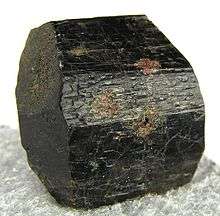Edenite
Edenite is a double chain silicate mineral of the amphibole group with the general chemical composition NaCa2Mg5(Si7Al)O22(OH)2. Edenite is named for the locality of Edenville, Orange County, New York, where it was first described.[3]
| Edenite | |
|---|---|
 Edenite crystal from Bancroft District, Ontario | |
| General | |
| Category | Amphibole mineral |
| Formula (repeating unit) | NaCa2Mg5(Si7Al)O22(OH)2 |
| Strunz classification | 9.DE.15 |
| Crystal system | Monoclinic |
| Crystal class | Prismatic (2/m) (same H-M symbol) |
| Space group | C2/m |
| Unit cell | a = 9.83, b = 17.95 c = 5.3 [Å], β = 105.18°; Z = 2 |
| Identification | |
| Formula mass | 834.25 g/mol |
| Color | White to gray, pale to dark green, also brown and pale pinkish-brown |
| Crystal habit | Prismatic crystals, fibrous, as reaction rims on pyroxenes |
| Twinning | Simple or multiple parallel to {010} |
| Cleavage | Good on (110) |
| Fracture | Conchoidal |
| Tenacity | Brittle |
| Mohs scale hardness | 5–6 |
| Luster | Vitreous |
| Streak | White |
| Diaphaneity | Semitransparent |
| Specific gravity | 3.05 - 3.37 |
| Optical properties | Biaxial (+) |
| Refractive index | nα = 1.606 - 1.649, nβ = 1.617 - 1.660, nγ = 1.631 - 1.672 |
| Birefringence | δ = 0.025 |
| Pleochroism | Distinct, greens, blue-greens, and yellow-browns |
| 2V angle | 50–82° |
| References | [1][2][3][4] |
Occurrence
Edenite has been found primarily in metamorphic rocks, occurring in pods of other magnesium rich minerals within a marble formation or with garnet rich lherzolites from deep within the Earth's crust.[5][6] Thus, finding edenite in the field can indicate high temperature regional metamorphism of the surrounding rocks.
Uses and importance
While edenite is not important for commercial or industrial applications, it is often studied because of its unique chemical substitution properties. Results from research performed on amphiboles have shown that edenite is particularly suited for fitting chlorine anions into its chemical framework.[7] This makes edenite a good candidate for use in chlorine isotope fractionation in amphibole-bearing rocks. Many synthetic variations of edenite are also used in geochemical research to produce a boron analogue of fluroedenite.[8]
Crystal habit
Edenite is a member of the monoclinic crystal system and is in the crystal class 2/m (space group C2/m).[5] This means crystalline edenite is symmetrical around a two-fold rotation axis that is then reflected across a mirror plane perpendicular to the long axis of the mineral.[9]
Optical properties
Edenite is a biaxial positive mineral. When viewed in thin section with a petrographic microscope, it is white-gray with pale green pleochorism in plane-polarized light. Under crossed polars, its interference colors range from first order gray to first order blue.[2]
References
- Edenite Handbook of Mineralogy
- Edenite on Mindat.org
- Edenite on Webmineral
- IMA Master List
- Oberti, R.; Cámara, F.; Della Ventura, G.; Iezzi, G. & Benimoff, A.I. (2006). "Parvo-mangano-edenite, parvo-manganotremolite, and the solid solution between Ca and Mn2+ at the M4 site in amphiboles" (PDF). American Mineralogist. 91 (4): 526–532. doi:10.2138/am.2006.1905.
- Yang, J. (2003). "Relict edenite in a garnet lherzolite from the Chinese Su-Lu UHP metamorphic terrane: Implications for metamorphic history" (PDF). American Mineralogist. 88: 180–188. Archived from the original (PDF) on 2012-03-29.
- Oberti, R.; Hawthorne, F.C.; Cannillo, E. & Cámara, F. (2007). "Long-Range Order in Amphiboles". Reviews in Mineralogy and Geochemistry. 67: 125–171. doi:10.2138/rmg.2007.67.4.
- Oberti, R.; Della Ventura, G. & Cámara, F. (2007). "New Amphibole Compositions: Natural and Synthetic". Reviews in Mineralogy and Geochemistry. 67: 89–124. doi:10.2138/rmg.2007.67.3.
- Klein, C., and Dutrow, B. (2007) The 23rd Edition of the Manual of Mineral Science, John Wiley and Sons, Inc. Hoboken, New Jersey, U.S..